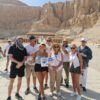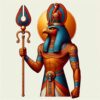Who Was Ramses II?
Ramses II, also known as Ramses the Great, stands as one of the most powerful and influential pharaohs in ancient Egypt. He ruled for 66 years, from 1279 to 1213 BCE, one of the longest reigns in Egypt’s history. Ramses II’s reign was marked by military triumphs, grand construction projects, and a lasting impact on Egypt’s culture. In this blog post, we will explore his life, military victories, and monumental achievements, showing why Ramses II continues to captivate people today.
Early Life of Ramses II
Ramses II was born around 1303 BCE to Seti I and Queen Tuya. Growing up in the royal palace, he received a training fit for a future leader. Seti I, his father, taught him the ways of leadership and warfare. Ramses became a co-regent with his father at just 14, learning firsthand how to govern Egypt. When Seti I passed away, Ramses ascended to the throne at the age of 25, ready to lead the kingdom.
Ramses II’s Military Campaigns
Ramses II earned a reputation as a fierce and successful military leader. Throughout his reign, he fought several significant battles and expanded Egypt’s territory. His most notable military achievement was the Battle of Kadesh, fought against the Hittites in 1274 BCE.
The Battle of Kadesh: A Major Victory
The Battle of Kadesh remains one of the largest chariot battles in history. Ramses led his forces against the Hittites near the city of Kadesh, located in modern-day Syria. The battle was intense and nearly resulted in defeat for Egypt. However, Ramses turned the situation around, claiming victory. He used the event to solidify his image as a powerful leader, commissioning inscriptions across Egypt that depicted him as the victor.
Despite the outcome, Ramses negotiated a peace treaty with the Hittites. This treaty stands as one of the first known peace agreements in history. It helped maintain stability in the region, allowing Ramses II to focus on strengthening Egypt.
Expansion of Egypt’s Borders
Ramses II didn’t limit his military efforts to the Hittites. He also fought against the Libyans to the west and several other groups along Egypt’s southern border. His military campaigns expanded Egypt’s territory and kept its borders secure. Ramses understood the importance of diplomacy and often balanced military conquest with peaceful negotiations.
Ramses II’s Monumental Building Projects
Ramses II is famous for his large-scale building projects. He commissioned the construction of some of Egypt’s most iconic monuments. These structures not only served a functional purpose but also reflected Ramses’ power and desire to leave a lasting legacy.
The Temple of Abu Simbel
One of Ramses II’s most famous constructions is the Temple of Abu Simbel. Located in southern Egypt, this temple was carved directly into the mountainside and features four massive statues of Ramses. The temple honored both Ramses and the gods of Egypt. The intricate design showcases Ramses’ understanding of architecture, astronomy, and engineering.
The temple is designed so that, twice a year, the sun shines directly into the inner sanctum, illuminating statues of Ramses and the gods. This clever alignment demonstrates the advanced knowledge and skills of Egyptian architects during Ramses II’s reign.
The Ramesseum: A Symbol of Ramses’ Glory
Another monumental project was the Ramesseum, a grand temple complex located in Thebes. The temple, dedicated to Ramses II, featured colossal statues of the pharaoh, grand halls, and chambers dedicated to the gods. Though much of the temple is in ruins today, the remains continue to impress visitors and historians alike. The Ramesseum stands as a testament to Ramses’ devotion to both his gods and his legacy.
Ramses II’s Contributions to Art and Culture
Ramses II’s influence extended beyond military and architectural achievements. He was also a great patron of the arts. Under his reign, Egyptian art and culture flourished, with numerous statues, paintings, and carvings created to honor both Ramses and the gods.
Art and Statues
Many statues of Ramses II were created during his reign. These statues often depict him as a powerful, divine ruler, with a strong physique and a commanding presence. The statues served to inspire respect and awe in both Egyptians and foreign visitors. They showcased Ramses as a god-like figure who ruled Egypt with authority and grace.
Literature and Inscriptions
Ramses II also encouraged the creation of written works that chronicled his victories and accomplishments. These inscriptions, carved into temples and monuments across Egypt, helped cement his reputation as a great ruler. They also preserved Egypt’s cultural heritage for future generations. His legacy, as recorded in these texts, continues to offer valuable insights into ancient Egyptian history.
The Family of Ramses II
Ramses II had a large family, with more than 100 children. His most famous wife, Queen Nefertari, played a key role in his reign. Nefertari was not only his chief queen but also a powerful figure in her own right. She had a tomb built for her in the Valley of the Queens, famous for its stunning wall paintings.
Many of Ramses’ children served in important roles throughout Egypt, and some married into royal families from other nations. This helped strengthen Egypt’s political alliances and ensured stability throughout his reign.
Death and Legacy
Ramses II passed away at the age of 90, having ruled for an extraordinary 66 years. His death marked the end of an era in Egyptian history. He was buried in the Valley of the Kings, where his tomb was rediscovered by archaeologists. Today, his mummified body rests in the Egyptian Museum in Cairo, where it remains one of the most famous exhibits.
Ramses’ legacy endures in the temples, monuments, and inscriptions he left behind. He is remembered not only as a great military leader but also as a visionary who shaped the future of Egypt. His achievements in art, architecture, and diplomacy ensured that he would be remembered for millennia.
Why Ramses II Is Still Remembered Today
Ramses II, the Great Pharaoh, remains one of the most celebrated figures in ancient Egyptian history. His military victories, monumental constructions, and cultural contributions made him a powerful ruler who shaped Egypt’s future. The temples he built and the stories of his accomplishments continue to inspire awe today. Ramses II’s legacy is a reminder of the greatness of ancient Egypt and the extraordinary rulers who shaped its history. Explore Egypt’s timeless beauty with our expertly planned Nile River cruise.
Frequently Asked Questions (FAQ) About Ramses II
Q1: How long did Ramses II rule Egypt?
Ramses II ruled Egypt for 66 years, from 1279 to 1213 BCE. His reign remains one of the longest in Egyptian history.
Q2: What was the Battle of Kadesh?
The Battle of Kadesh was a major chariot battle fought between Ramses II and the Hittites in 1274 BCE. Though the battle ended without a clear victor, Ramses claimed victory and later signed a peace treaty with the Hittites.
Q3: What are some of Ramses II’s most famous building projects?
Ramses II is known for constructing the Temple of Abu Simbel and the Ramesseum. Both temples are marvels of ancient Egyptian architecture.
Q4: What was Ramses II’s legacy?
Ramses II is remembered for his military prowess, monumental building projects, and cultural contributions. His reign represents a golden age in Egyptian history.
Begin your adventure today with our custom-tailored trips to Egypt.




